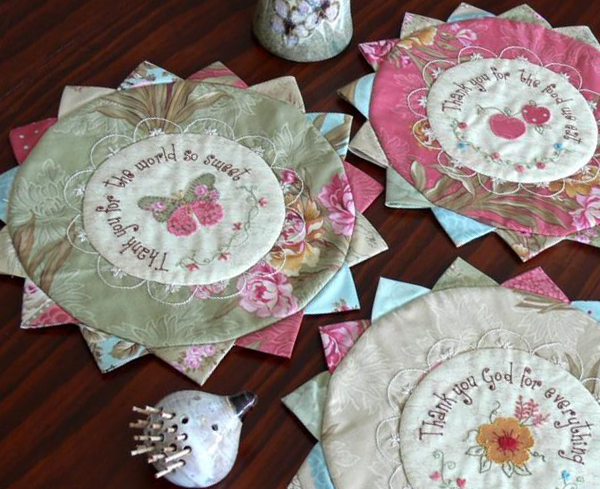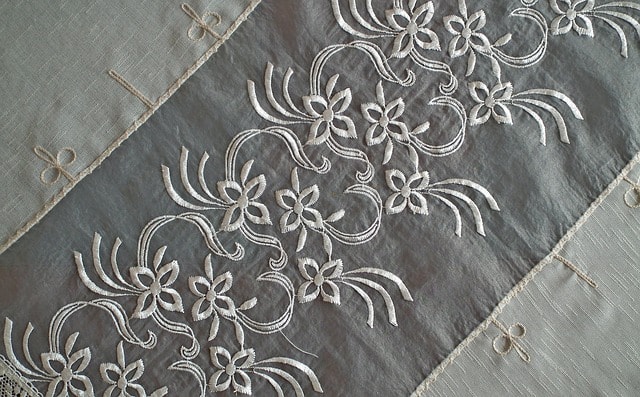Introduction
Embroidery is a decorative art of embellishing fabric or other materials using thread, yarn, or other materials to create designs and patterns. It has been used for centuries to add beauty and personality to clothing, home decor, and other items. Embroidery machines are specialized machines that automate the embroidery process, allowing for faster and more precise designs.

Choosing the right fabric is crucial for successful embroidery. The fabric should be compatible with the chosen embroidery technique and design. The wrong fabric can cause problems like puckering, thread breakage, or distortion. Additionally, the fabric should be sturdy enough to handle the weight and density of the embroidery without tearing or stretching. Factors to consider when choosing fabric for embroidery include the type of fiber, weave, weight, and color. By selecting the right fabric, the embroidery will look beautiful and professional, and the final product will be durable and long-lasting.
Choosing the Right Fabric
When choosing fabric for embroidery, there are several factors to consider to ensure that the final product looks great and lasts a long time. Here’s an overview of the different types of fabric and the factors to consider:
Type of Fiber: Fabrics can be made from natural fibers such as cotton, silk, wool, and linen, or synthetic fibers like polyester and nylon. Each fiber type has its own properties and characteristics that can affect the embroidery process. For example, cotton is a popular choice for embroidery because it is sturdy, absorbent, and easy to work with, while silk is more delicate and requires more care.
Weave: The way the fabric is woven can affect how well it holds up to embroidery. Fabrics with a tight weave like poplin, twill, and denim are good choices for embroidery because they are less likely to pucker or distort.
Weight: The weight of the fabric can also affect the embroidery process. Lighter fabrics like chiffon and organza may be too delicate for dense embroidery designs, while heavier fabrics like canvas or denim may require more stabilization to prevent puckering or distortion.
Color: The color of the fabric can also impact the embroidery design. Light-colored fabrics can make the embroidery design stand out more, while darker fabrics may require lighter thread colors to show up well.
In addition to these factors, it’s also important to consider the embroidery technique being used, the size and complexity of the design, and the intended use of the finished product. By taking all of these factors into account, you can choose the best fabric for your embroidery project and ensure a beautiful, long-lasting finished product.
III. Preparing for Embroidery
Preparing for embroidery is an important step in ensuring that the final product looks great and lasts a long time. Here are three key steps to take:
Choosing the right needle and thread: The type and size of the needle and thread you use will depend on the fabric and design you’re working with. A general rule of thumb is to use a smaller needle and lighter weight thread for lighter weight fabrics, and a larger needle and heavier thread for heavier fabrics. Be sure to choose a needle and thread that are compatible with your embroidery machine.

Hooping the fabric correctly: Hooping is the process of securing the fabric in the embroidery hoop so that it stays in place during the embroidery process. It’s important to hoop the fabric correctly to prevent puckering, distortion, or other issues. Start by selecting the appropriate size hoop for your design and fabric. Place the inner hoop underneath the fabric, and the outer hoop on top, making sure the fabric is taut but not stretched. Tighten the hoop screw to secure the fabric in place.
Setting up the embroidery machine: Once you have the fabric hooped and the needle and thread selected, it’s time to set up the embroidery machine. Start by threading the machine and inserting the appropriate needle size. Choose the design you want to embroider and load it onto the machine. Adjust the machine settings such as stitch speed, tension, and density to match the fabric and design. Test the embroidery on a scrap piece of fabric before starting on your actual project to ensure that everything is set up correctly.
By taking these steps to prepare for embroidery, you can ensure that the finished product looks great and lasts a long time.
Tips for Embroidering on Different Fabrics
Embroidering on different fabrics can present unique challenges and require different techniques. Here are some tips for embroidering on different fabrics:
Cotton: Cotton is a popular fabric for embroidery because it’s sturdy and easy to work with. To ensure the best results, choose a tight weave cotton fabric and use a lightweight stabilizer to prevent puckering. You can also pre-wash the fabric to prevent shrinkage.
Silk: Embroidering on silk requires a delicate touch. Use a lightweight silk fabric and a fine needle and thread. A water-soluble stabilizer can be helpful to prevent puckering and distortion.
Denim: Denim can be a challenging fabric to embroider on because it’s heavy and stiff. Use a denim needle and heavyweight thread for best results, and stabilize the fabric with a heavyweight cutaway stabilizer. Pre-washing the fabric can also help soften it and make it easier to embroider.
Leather: Embroidering on leather requires a special needle and thread designed for leather. Use a lightweight stabilizer and avoid hoop marks by using adhesive spray or pins to secure the fabric.
Fleece: Fleece is a soft, fluffy fabric that can be tricky to embroider on because it tends to stretch and shift. Use a lightweight cutaway stabilizer and a ballpoint needle to prevent damage to the fabric. You can also use a water-soluble topping to help keep the stitches from sinking into the fleece.
By following these tips, you can successfully embroider on a variety of fabrics and achieve beautiful, long-lasting results.
Maintenance and Troubleshooting
Proper maintenance of your embroidery machine is important to keep it running smoothly and prevent common problems. Here are some maintenance tips and troubleshooting techniques to keep in mind:
Maintenance:
Clean the machine regularly: Regular cleaning can prevent build-up of dust and debris that can cause the machine to malfunction. Follow the manufacturer’s instructions for cleaning and lubricating the machine.
Check and tighten screws: Over time, screws can loosen and cause the machine to vibrate or make noise. Check and tighten all screws periodically to prevent this.

Replace needles regularly: Dull or bent needles can cause skipped stitches or damage to the fabric. Replace needles after every project or when they become dull.
Keep the machine covered: When not in use, cover the machine to protect it from dust and debris.
Troubleshooting:
Thread breakage: If the thread keeps breaking, check the tension and make sure the thread is threaded correctly. Also, check for burrs on the needle and thread guides.
Skipped stitches: If the machine skips stitches, check the needle size, make sure the needle is inserted correctly, and check the tension.
Puckering: If the fabric puckers, make sure the fabric is hooped correctly and the stabilizer is the right weight for the fabric.
Machine jams: If the machine jams, stop the machine and check for any thread or fabric caught in the mechanism. Also, check for bent needles or damaged parts.
Error messages: If the machine displays an error message, consult the manual or contact the manufacturer for troubleshooting advice.
By properly maintaining your embroidery machine and addressing common problems as they arise, you can keep your machine running smoothly and create beautiful embroidery projects with ease.
Conclusion
In conclusion, choosing the right fabric for embroidery is crucial to achieving beautiful and long-lasting results. Factors such as the weave, weight, and texture of the fabric should be considered before beginning an embroidery project.
When embroidering on different fabrics, it’s important to use the appropriate needle, thread, and stabilizer to prevent puckering, skipped stitches, and other issues. Cotton, silk, denim, leather, and fleece each present unique challenges, but with the right techniques, beautiful embroidery can be achieved on any fabric.
Finally, don’t be afraid to experiment with different fabrics and techniques to expand your embroidery skills. With practice and patience, you can create stunning embroidery projects on a variety of fabrics. Remember to maintain your embroidery machine properly and troubleshoot common issues as they arise to ensure consistent and high-quality embroidery.
See Also-
- Best Affordable Embroidery Machine 2023
- Best Embroidery Machine For Patches 2023
- Best Commercial Embroidery Machine 2023
- Best Embroidery Machine For Clothing 2023
- Best Janome Embroidery Machine 2023
